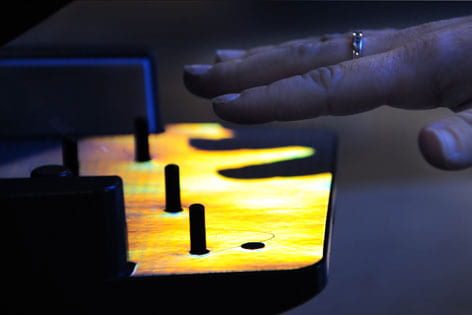Access recreation center with just a touch
Palm-reading technology allows Anteater Recreation Center members to check in without breaking a sweat.

It may look like the kind of high-tech gizmo seen on “Mission Impossible,” but a new hand scanner at Anteater Recreation Center isn’t designed to keep out spies: It allows ARC members to enter the facility without breaking a sweat.
In March, UC Irvine became the first University of California campus to install the new biometric system, though some state schools – such as San Diego State University – have been using the technology for years. Campus Recreation watched two schools that recently implemented the systems – Cal State Fullerton and Cal State San Bernardino – to see how well they worked before committing to one for UCI.
“Every UC school is looking at this as an option,” says Jill Schindele, director of Campus Recreation.
On a recent afternoon at the ARC, the system was seamless: Students placed their palms on a metal plate, lining their fingers up with metal guides and a hand outline, entered their personal identification numbers and passed quickly through the turnstiles to begin their workouts.
“I love it because I always used to forget my ID card,” says senior Ashlynn Brown, a history and political science major, as she headed into the ARC with her gym bag.
A few students still don’t trust the technology. They see the scanner as a sign Big Brother has arrived on campus and refuse to register their hands, opting to use their old ID cards. Most, however, welcome the new system, Schindele says, because it keeps them from being turned away at the door if they forget their ARC cards.
“Working with students who don’t carry their ID cards with them is a constant challenge for every campus recreation center,” she says. “Turning students away is bad customer service.”
The system also prevents members from lending their cards to friends and keeps out nonmembers when stolen or lost cards fall into the wrong, er, hands.
The scanner doesn’t take palm prints; it analyzes more than 31,000 points and 90 measurements on the hand – including length, width, thickness and surface area – and compares the data with that on file for a member’s PIN. While not as unique as a fingerprint, hand geometry is precise enough that there’s little chance of two palms matching.
“It’s all part of evolution, to make it more convenient for users. Who knows? Someday we might even do retinal scanning,” Schindele says. “We like making sure the ARC is on the cutting edge.”